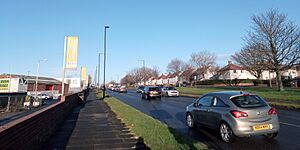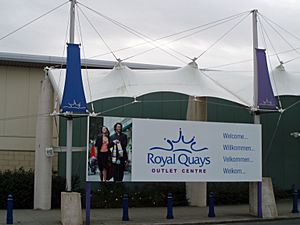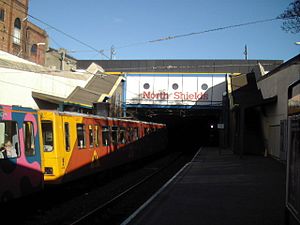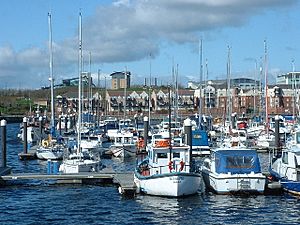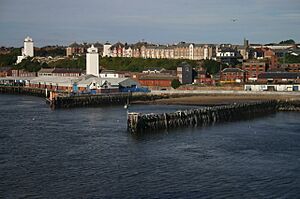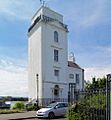North Shields facts for kids
Quick facts for kids North Shields |
|
|---|---|
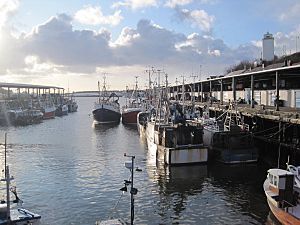 North Shields Fish Quay |
|
| Population | 34,423 (2011 census North Tyneside wards of Chirton, Collingwood and Riverside) |
| OS grid reference | NZ3568 |
| Metropolitan borough |
|
| Metropolitan county | |
| Region | |
| Country | England |
| Sovereign state | United Kingdom |
| Post town | NORTH SHIELDS |
| Postcode district | NE29, NE30 |
| Dialling code | 0191 |
| Police | Northumbria |
| Fire | Tyne and Wear |
| Ambulance | North East |
| EU Parliament | North East England |
| UK Parliament |
|
North Shields is a town located in the borough of North Tyneside in Tyne and Wear, England. It's about 8 kilometres (5 miles) north-east of Newcastle upon Tyne. The town is right next to Wallsend and Tynemouth.
North Shields sits on the northern bank of the River Tyne, directly across from South Shields. The name "Shields" comes from an old word, schele, which meant "temporary sheds or huts used by fishermen". This gives you a clue about how the town started!
Contents
Discovering North Shields
A Look Back in Time
North Shields was first mentioned in records way back in 1225. The Prior of Tynemouth, Germanus, decided to create a fishing port here. His goal was to provide fish for the Priory and supply ships anchored nearby.
Simple huts, called 'shiels', were built where the Pow Burn stream met the River Tyne. Wooden docks were also put up to unload fishing boats. These docks were also used to ship coal from mines owned by the Priory. Soon, about 1,000 people lived in this new settlement.
The people of Newcastle upon Tyne, who controlled trade on the river, weren't happy about this new port. They tried to stop trade from North Shields, but despite their efforts, the town continued to grow. It became an important place for fishing and exporting salt.
How the Town Grew
The town first developed on a narrow strip of land along the river, which quickly became crowded. In the 1700s, people started building homes on the higher ground, about 18 metres (60 feet) above the old riverside area. Wealthy business owners and ship owners moved to this new, higher part of town. Working people often stayed in the lower, older part.
Stairs connected the lower and higher parts of town. One of the first new developments was Dockwray Square, built in 1763. These were fancy houses for rich families. Later, these families moved to the even newer Northumberland Square, and Dockwray Square became less grand. Interestingly, the famous comedian Stan Laurel lived in Dockwray Square for a few years before he became well-known. Today, there's a statue of him in the square.
In 1796, plans were made for a grand street, now called Howard Street, leading to the beautiful Georgian Northumberland Square. The Tynemouth Town Hall, a historic building, was built nearby in 1844–45.
Where is North Shields?
North Shields is bordered by Whitley Bay to the north and the River Tyne to the south. Tynemouth is to its east, and the A19 road separates it from Wallsend to the west. It's part of a larger group of towns called the North Tyneside conurbation.
Over the years, North Shields has grown. It now includes areas like Chirton, Preston, Billy Mill, Percy Main, East Howdon, and the Marden estate.
Town Centre Plans
The North Tyneside Council has exciting plans to make the town centre even better. These ideas include creating a special path to the Fish Quay, making some streets just for walkers, and building a new town square. They also plan to improve Northumberland Square and create a new transport hub.
In 2020, work was finished on restoring buildings near Northumberland Square and building new homes on Albion Road. The famous Wooden Dolly statue was also returned to the square after being restored. A new square near Bedford Street was completed in September 2023 as part of the Transport Hub project.
Meadow Well Estate
Meadow Well is a large housing area to the west of North Shields. It was built in the 1930s for people who moved from older, crowded parts of the town. The homes were later updated in the 1960s and 70s. The name "Meadow Well" comes from a well that was once in a meadow where the estate now stands.
In 1991, there were some serious events in Meadow Well that led to changes and improvements in the area. Since then, local groups like the Cedarwood Trust and Meadow Well Connected have worked hard to help the community. The film Dream On (1991) was set in this area.
Royal Quays
The Royal Quays area has been completely transformed! It used to be old docks, but now it's a lively place with homes, fun activities, offices, and businesses. This big project cost £16 million.
You can find the Wet N Wild indoor water park, an outlet shopping centre, a bowling alley, and a marina here. There's also a cool sculpture called Tyne Anew by artist Mark di Suvero. The shopping centre was renamed Newcastle Quays Retail in early 2024.
Fish Quay
The North Shields Fish Quay has also seen big changes. New luxury apartments have been built, and old buildings have been turned into restaurants and bars. It's still a working quay where fishing boats come and go. The local council is planning even more improvements to make it a great place for food and drink.
Smith's Docks
The old Smith's Docks area is being redeveloped with new homes. Some of these homes were designed by the famous architect George Clarke. Work on these new homes started in 2017 and is continuing.
Heritage Action Zone
North Shields has received funding to improve its historic areas, especially around Howard Street and Northumberland Square. The goal is to make these areas more attractive and better connected for people walking around.
What North Shields Makes and Does
Past Industries
In the past, North Shields was known for making marine engines, chains, and anchors. It also had shipbuilding yards, rope factories, salt-works, and factories for earthenware and stained glass. Fishing was a huge industry, providing many jobs. The Smith's Dock Company was a major employer for many years, closing in 1987.
Shipyards
Shipyards have been in North Shields almost since the town began. Smaller yards built traditional fishing boats called Northumbrian cobles. Larger yards built wooden sailing ships used to carry coal to London. Over time, these small yards were replaced by bigger ones like the Tyne Dock and Engineering Company and the Smith's Dock Company. These yards built iron ships for fishing and coal trade. Later, they focused on ship repair. Today, none of these shipyards remain.
Modern Industries
North Shields still has maritime companies because of its history with fishing and shipbuilding. John Lilley and Gillie Ltd, a company that makes marine equipment, is based here.
Mining
Coal mines were located in nearby villages that are now part of North Shields, such as Preston, Percy Main, and New York.
Office and Business Parks
After coal mining and shipbuilding declined, new business parks and industrial estates were created. These offer different types of jobs. Two of the biggest are The Silverlink and Cobalt Park, which is one of the largest office parks in the UK. Cobalt Park is home to a large Orange call centre. You can also visit the Stephenson Railway Museum near The Silverlink, which celebrates the town's connection to early railways.
Other Businesses
Potts Print, a printing company, started in North Shields in 1875. Spicers has a large factory in the town that produces tea.
Did you know that Donald Campbell's famous boat, Bluebird K7, which crashed during a water speed record attempt, was restored in a workshop right here in North Shields?
Getting Around North Shields
Metro (Train)
The first railway in North Shields opened in 1839. Today, the town is part of the Tyne and Wear Metro system. The Metro connects North Shields to Newcastle city centre, Whitley Bay, Newcastle Airport, and Sunderland.
The main town centre station was updated for the Metro in the early 1980s and again in 2012. You can also find Metro stations in Percy Main and Meadow Well.
Ferries
Local Ferry
A ferry service runs every half hour, connecting North Shields to South Shields across the Tyne. The current Shields Ferry started in 1972.
International Ferry
From the International Ferry Terminal at Royal Quays, the Danish company DFDS Seaways offers a daily ferry service to IJmuiden in the Netherlands. This terminal also welcomes many cruise ships, bringing visitors to explore Newcastle and the North East of England.
Buses
A new transport hub, next to the Metro station, opened in September 2023. It's special because it was built to be completely carbon-neutral, meaning it doesn't add to carbon emissions during its construction or operation.
Learning in North Shields
North Shields has a three-part school system:
- Nursery schools
* Sir James Knott Nursery School
- Primary schools
* Christ Church Church of England Primary School * Collingwood Primary School * King Edward Primary School * Kings Priory School * Monkhouse Primary School * Percy Main Primary School * Preston Grange Primary School * Riverside Primary School * Spring Gardens Primary School * St Cuthberts Roman Catholic Primary School * St Josephs Roman Catholic Primary School * Waterville Primary School * Whitehouse Primary School
- High schools
* John Spence Community High School, Preston * Kings Priory School, Tynemouth * Marden High School, Cullercoats * Norham High School, Chirton * St Thomas More RC Academy, Billy Mill
Fun and Games
Sports
North Shields is home to the football club North Shields F.C., founded in 1896. They play their home games at Daren Persson Stadium. The team has famously won two major cups at Wembley Stadium: the FA Amateur Cup in 1969 and the FA Vase in 2015.
Leisure Facilities
The Parks Sports Centre opened in 1998. It has a big sports hall, a gym, outdoor football pitches, and facilities for indoor and outdoor bowls.
Royal Quays Fun
The Wet'n'Wild indoor water park opened in 1993 at Royal Quays. It had exciting slides like the "Twister," which was 85 metres (279 feet) long and started from a height of 12.5 metres (41 feet)! It closed in 2020.
A bowling alley, now called Gutterball, is also part of the Royal Quays development. In 2017, Xtreme Bounce, a trampoline park, opened in the car park. This was later taken over by Inflatanation, which replaced the trampolines with inflatables.
Parks and Play Areas
North Shields has several lovely parks and play areas for everyone to enjoy.
Northumberland Park
Northumberland Park is on the border of North Shields and Tynemouth. It was created around 1885. In 2015, the council completed a big project to restore parts of the park, bringing back historical features and adding new facilities like a cafe. The park has a children's play area, bowling greens, and even a historic pet cemetery.
Other Parks
- West End Park is next to The Parks sports centre.
- Linear Park runs down to the Royal Quays Marina.
- Redburn Dene was created as part of the Royal Quays development and features sculptures made from old dock materials. It even won a Green Flag award in 2020!
There are also many smaller play areas around the town, including Pearson Park, Alexander Scott Park, and playsites in Holmlands, Percy Main, and East Howdon.
Library
The main library in North Shields is located in Northumberland Square. It was built in 1973 and was designed to be very quiet, even though it's built over a Metro tunnel! The library was updated in 2013, making more space for books and computers.
Famous Faces from North Shields
Many interesting people have connections to North Shields:
- Ralph Gardner was a local hero who stood up for the town's rights against Newcastle in the 1600s. A housing estate is named after him.
- Stan Laurel (born Arthur Stanley Jefferson) was a world-famous film comedian, part of the duo Laurel and Hardy. He lived in North Shields for a few years.
- William Harbutt invented Plasticine, the popular modelling clay!
- George Stephenson and his son Robert Stephenson were pioneering engineers who helped develop railways.
- William Wouldhave is credited with inventing the lifeboat.
- Sam Fender is a popular musician from North Shields.
- Neil Tennant is the main singer for the famous band Pet Shop Boys.
- Andy Taylor and Hilton Valentine are musicians, with Hilton being a founding member of The Animals.
- Robert Westall was a well-known children's author.
Landmarks to See
Lights of North Shields
For centuries, lights have guided ships safely into the River Tyne, helping them avoid dangerous rocks. The "High and Low lights" were built in the 16th century and rebuilt in 1727. These historic buildings still stand today! They were used by sailors as important guides. Today, some of these old light buildings are private homes, but they are still famous landmarks. The Old Low Light, which was restored in 2014, is now a public heritage centre with a cafe, museum, and viewing platform.
Fish Quay
In 1806, a market opened on New Quay. Then, in 1870, work began on building the North Shields Fish Quay to protect fishing boats. This quay is still used by fishermen today! In 2017, a large steel sculpture of a lone fisherman, called Fiddler's Green, was placed on the quay to remember fishermen lost at sea.
Clifford's Fort
Clifford's Fort, located on the Fish Quay, was built in the 1600s to defend against the Dutch. It was also important during the Napoleonic Wars and World War I. The fort was eventually sold and redeveloped for fish processing. Today, not much of the original fort remains, but its walls are still there. The area has been restored, and you can see parts of its history, like old gun positions. The Old Low Light, a Grade II-listed building within the fort, is now a Heritage Centre.
Wooden Dolly
One of North Shields' oldest and most unique landmarks is the "Wooden Dolly" statue. The first Wooden Dolly was a female figurehead from a ship, placed at Custom House Quay in 1814. Sailors believed cutting pieces of wood from her would bring good luck on their voyages! Over the years, several Wooden Dollies have stood in the town. The fifth Wooden Dolly, a fishwife, was in Northumberland Square and is being restored. A sixth Wooden Dolly, also a fishwife, can be seen today at the entrance to Custom House Quay.
Gallery
Culture and Entertainment
Art in Town
You can find interesting art around North Shields. Fiddler's Green, a steel sculpture, remembers fishermen lost at sea. There are also many artworks around the Royal Quays development, including pieces by artists like Mark di Suvero and Perminder Kaur.
North Shields on Screen
North Shields has been featured in films and TV shows! The film Dream On (1991) was set in Meadow Well. The BBC series When the Boat Comes In was set in a fictional town inspired by North Shields and filmed there. Episodes of Spender and Vera have also been filmed in the town.
Music Inspired by North Shields
The famous Swedish singer Evert Taube wrote a song called "Mary Strand," which is set in North Shields in 1909. It tells the story of a young sailor hiding from the police in a cigar shop on Dock Street.
Twin Town
In 2017, North Shields became "twinned" with Merthyr Tydfil in Wales. This project aimed to connect towns with similar histories and challenges to help them learn from each other and make positive changes.
News and Media
You can get local news and TV programmes from BBC North East and Cumbria and ITV Tyne Tees. Local radio stations include BBC Radio Newcastle, Heart North East, and Capital North East. The town is also served by local newspapers like the Shields Gazette and Evening Chronicle.



